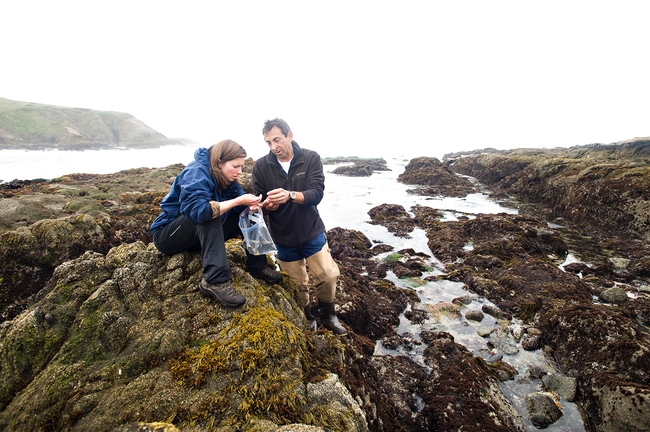UC Blogs
Institute ushers in new era of marine sciences
The new Coastal and Marine Sciences Institute at UC Davis will bring a new undergraduate program in marine sciences, a spruced-up Bodega Marine Laboratory, and enhanced opportunities for collaboration and education among marine scientists spread across UC Davis.
From the laboratories at the university’s main campus near the state’s political center of Sacramento to the shores of Bodega Bay on California’s north coast, a diverse group of marine scientists and policymakers at UC Davis has been studying the most critical issues affecting oceans, and the creatures and people who depend on them. Now, the Coastal and Marine Sciences Institute will begin to connect, strengthen, and leverage those efforts.
UC Davis evolution and ecology professor Rick Grosberg (above) is the institute’s founding director.
“I hope to take the incredible expertise on our main campus and at the UC Davis Bodega Marine Laboratory to assemble a comprehensive, interdisciplinary program in marine science,” said Grosberg. “One of our goals is to pull together an exceptionally strong and diverse group of faculty and really build the health of the coastal ocean.”
The institute’s work primarily will focus on coastal Northern California — from north of Monterey to the California-Oregon border.
Ten faculty currently reside at Bodega Marine Laboratory, while 69 campus faculty consider themselves marine scientists. By providing a collaborative framework, the institute aims to enhance opportunities for research, teaching, outreach and stakeholder engagement surrounding marine sciences.
The Coastal and Marine Sciences Institute features four key components, expected to be rolled out over the next five years:
- Research enterprises that use novel combinations of existing expertise at UC Davis in the physical, biological and social sciences to address issues affecting coastal and ocean environments.
- New degree programs. CMSI plans to introduce a highly interdisciplinary undergraduate degree program in marine sciences, expected to launch in 2014. New graduate and professional training programs in marine sciences are also being developed.
- The Bodega Learning Center aims to educate and engage the public — from “K to gray” — about marine and coastal issues. It will be located at Bodega Marine Laboratory, with plans to further develop visitor exhibits and programs for schools, professional training and lifelong learning throughout Northern California.
- The Center for Coastal Ocean Issues will provide a forum for engaging with stakeholders, from the beginning, to identify and address challenges related to human, natural and economic coastal health. This includes bringing together scientists, government agencies, policymakers, ocean industries and the public.
The UC Davis Bodega Marine Laboratory sits amid the Bodega Marine Reserve about 100 miles west from the UC Davis campus and is ideally located for studying coastal health and human impacts that could affect it. The facility is in one of the world’s four major upwelling areas, which are highly productive — yielding 20 percent of global fish production while occupying less than 1 percent of the ocean surface area. BML is also near one of the most densely populated regions of the state — the San Francisco Bay area — where coastlines are increasingly impacted by human activities.
The laboratory was founded in 1960 by UC Berkeley and was transferred to UC Davis in 1983. Recent work includes research on ocean acidification and climate change, invasive species, fisheries management, the effects of oil spills on marine life, and a program to bring back the endangered white abalone from the brink of extinction.
The Foraging Force of a Honey Bee Colony
With all the talk about honey bee nutrition lately, just how much food does a honey bee colony need and how far can the workers fly to find find...
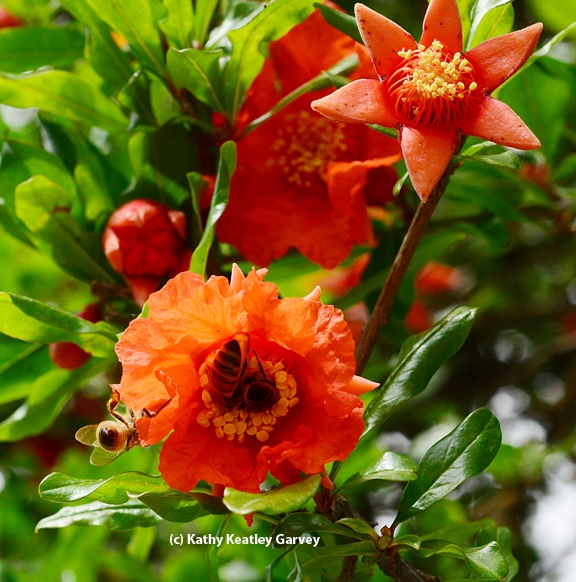
Honey bees foraging on pomegranate blossoms. (Photo by Kathy Keatley Garvey)
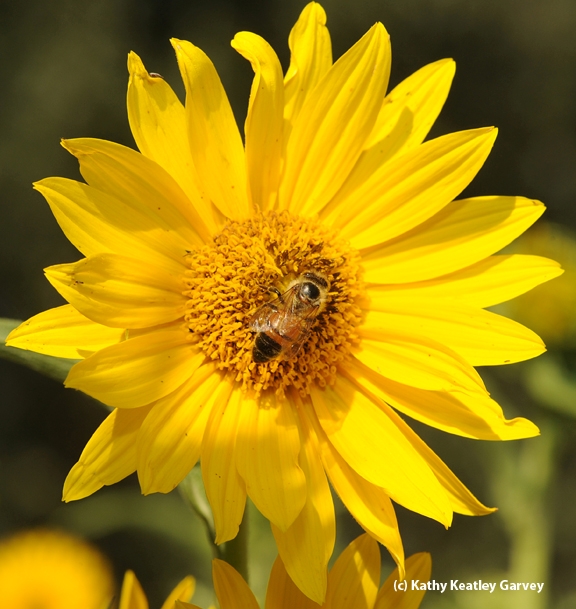
A single honey bee on a sunflower. (Photo by Kathy Keatley Garvey)
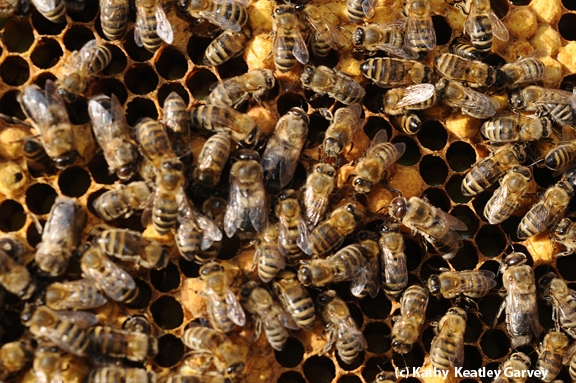
Inside the hive. (Photo by Kathy Keatley Garvey)
Transplanting, a Ruthless Way to Spend an Afternoon
Victoria Sackville-West (known as Vita) was one of England’s best-loved garden writers. From 1946 to 1961, she wrote a weekly garden column for The Observer newspaper. She was first a writer: poet, novelist and biographer, then a gardener, and her readers knew about the garden at Sissinghurst that she and her husband, Harold Nicholson, had created. They knew she was busy gardening and trusted her suggestions, valued her advice, and responded by sending her seeds and plants and letters by the truckload. Sissinghurst belongs to the National Trust and is the most-visited garden in a country that is obsessed with visiting gardens.
Vita Sackville-West had something to say about plantings and transplantings. She believed that one was as natural as the other. She didn’t fuss about the ‘mistakes’ we sometimes make, as she understood that all gardening is experimentation. Each planting we make is a testament to hope and optimism. We read, we research, we ask questions, but until we actually put that plant in our particular and peculiar garden, we really don’t know how it is going to work out. Of course there are plants we know to be safe bets, and we often need those to get a garden started. Look around your neighborhood and see what thrives in others’ gardens. Few real gardeners, however, are satisfied with those choices. We have to try new plants first glimpsed at our favorite nursery or mentioned in our favorite magazine. We find that we finally have a spot for the plant we have always intended to grow. Something else failed, sadly, but now we have room and the right sun exposure for that thing we’ve always meant to try.
Because gardening is experimentation, we don’t always get our plant combinations right. This is not failure; it’s just a part of the process. Sometimes the colors of flowering plants just don’t work together in a bed. Sometimes the plant we put in front of another grows too tall and one of them has to go. Plants crowd each other out, while in other parts of the garden, bare spots become apparent. Every plant grows at different rates from others, and each will have its own individual result in our individual gardens, thanks to soil and sun and water and cultural practice, AKA the work we put in. When this happens, Vita has a plan for us. She wrote, “Gardening is largely a question of mixing one sort of plant with another sort of plant, and of seeing how they marry happily together; and if you see that they don’t marry happily together, then you must hoick one of them out and be quite ruthless about it. That is the only way to garden.”
It seemed to me that I had been hoicking for quite some time, in my present garden and in previous ones. In fact, I had hoicked without actually knowing what it meant to hoick. So this morning I looked it up, just to be sure that what I assumed was hoicking was in fact hoicking. Two hardbound editions of Webster’s provided no assistance here. Once again I turned to Google and found assurance that my hoicking was what I thought it was: “ to lift or pull (something) with a quick movement”.
Sometimes one has to repeat those quick movements to obtain the right result. Hoicking is not for the weak or faint at heart. Yesterday’s hoicking involved a large Loropetalum chinense, or Chinese Fringe Flower, that was dwarfing and shading a Rhododendron that I wished to thrive. Until we dug and dug and hoicked and hoicked, we had no real sense of the size of this beast. Turns out it was a good 4 ½ feet tall and 3 feet wide, perfect to transplant to a bare spot where it will receive more sun and can fill out on all sides, assuming we haven’t hoicked so vigorously as to permanently damage what seemed to be very sturdy roots. I will remain optimistic about this move!
One thing in the garden of course leads to another, and thus it was with the Loropetalum removal. While holding back the neighboring azalea (also a Rhododendron, botanically speaking) so my fellow hoicker could hoick, I discovered a perfectly great Pittosporum tobira, or Japanese Mock Orange, living in near darkness under what must be nearly 50 years of azalea. Somebody years ago had clearly not bothered to hoick it out, but had cut it back to its thick trunk. Rather than succumbing to the lazy gardener’s wishes, it had refused to give up the ghost, instead sprouting large, tender dark green leaves struggling to find sunlight. More hoicking! Now this Pittosporum lives temporarily in a large pot, awaiting a permanent home to be prepared for it in just the right spot.
I hope I was as ruthless with my hoicking as Vita suggested all those years ago, because, as she said, “That is the only way to garden.”

Azalea and Pippi. (Photos by Diana Bryggman)
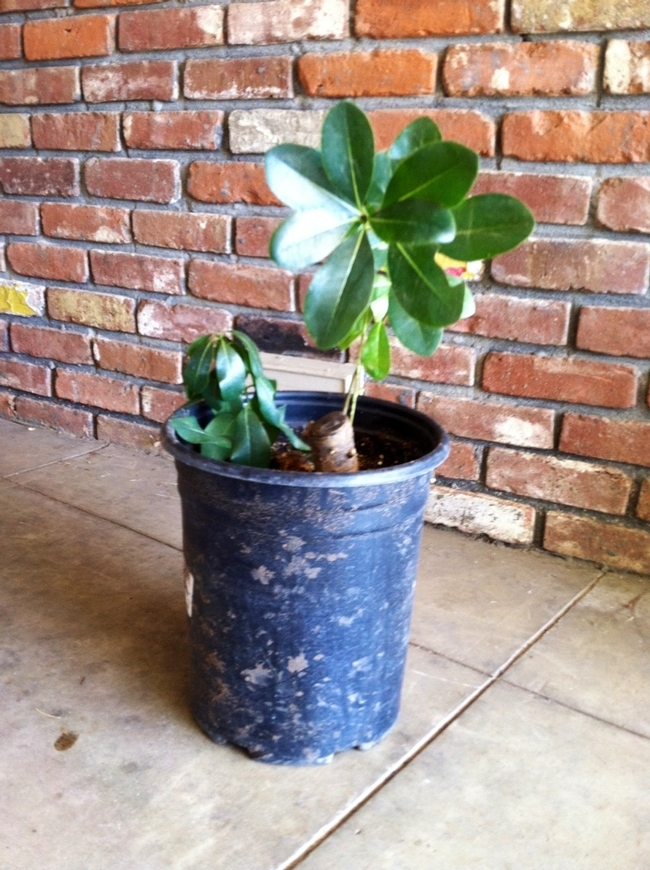
Pittosporum, potted up.
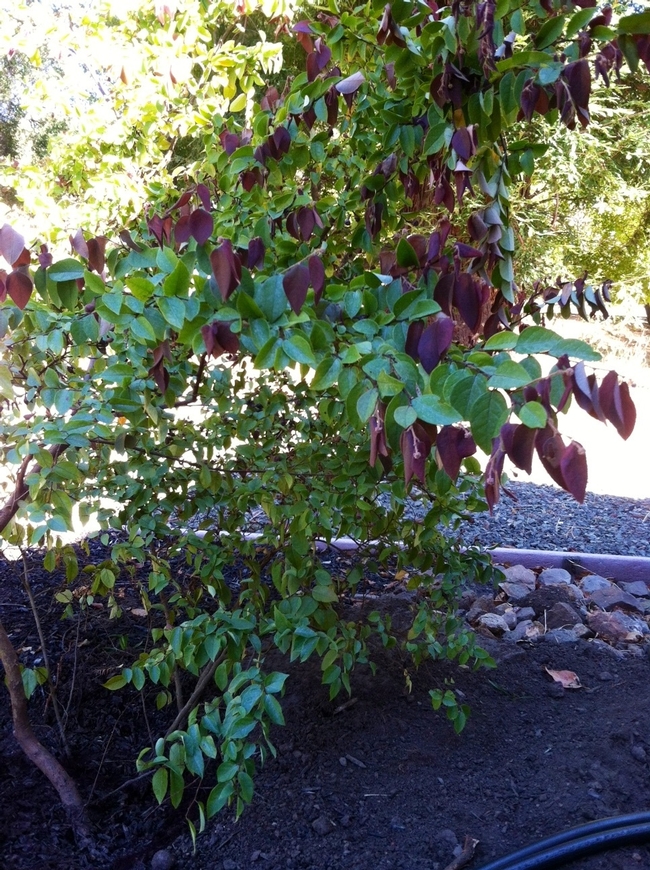
Loropetalum chinensis newly hoicked.
A Gulf Frit Kind of Day
It was a Gulf Fritillary kind of day last Saturday, Sept. 21 at the Bohart Museum of Entomology, UC Davis. That would be Agraulis...
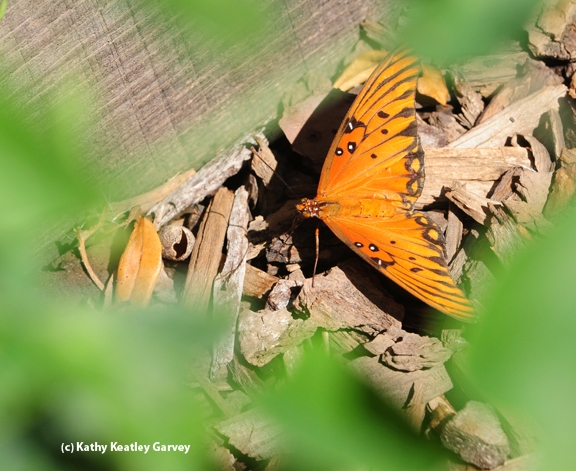
An adult Gulf Fritillary butterfly. (Photo by Kathy Keatley Garvey)
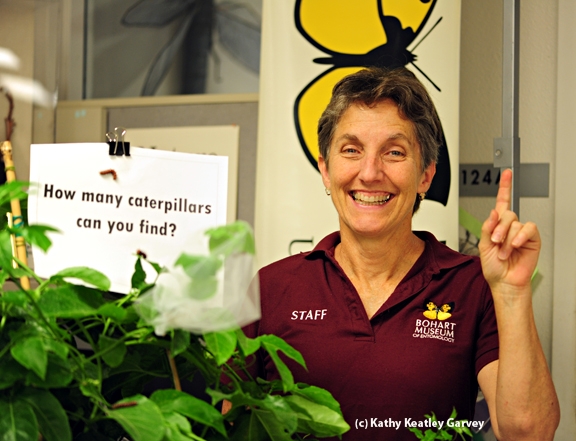
Lynn Kimsey, director of the Bohart Museum of Entomology and professor of entomology at UC Davis, holds up a finger to designate "One caterpillar." (Photo by Kathy Keatley Garvey)
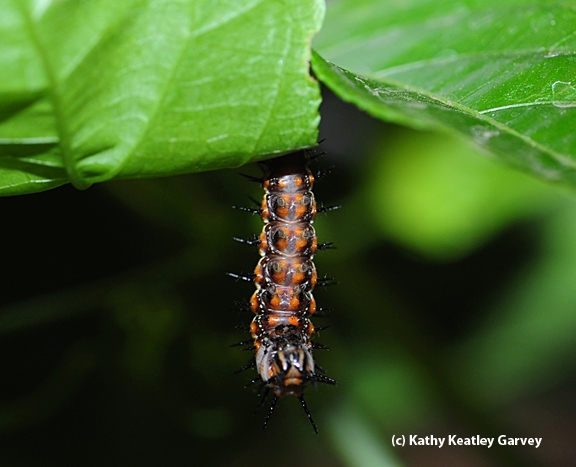
Caterpillar pupating. (Photo by Kathy Keatley Garvey)
Re-purposing a Tree Stump
If you read my July post on stunting sunflowers, you know I tend not to follow convention. But as I said then, the joy of gardening is in the hands of the individual. So this post on re-purposing a tree stump should not surprise you.
My driveway used to be lined with 50 plus year old Monterrey pine trees. But the past few years I’ve had to have several of them removed because they’ve been killed by tree borers. For the most recent pine tree I had cut down, I decided not to have the tree service remove the stump for budget reasons. Instead I had them just cut the stump down to about waist high. My idea at the time was to use the stump as a huge plant stand for one of my enormous planters. That idea quickly fell apart because my huge planter was just too heavy for me to lift onto the tree stump.
So I thought why not just plant something directly on top of the stump. To keep the soil confined to the top of the stump, I purchased some cheap plastic lawn edging, cut it the size of the stump, and fastened it together into a circle. I laid it on top of the stump and filled it with potting soil. I planted succulents around the edges, but I wanted a deeper soil depth to plant some marigolds. So I cut and fastened a smaller circle of lawn edging and centered it on top of the already poured potting soil. I filled the smaller circle with soil and planted the flowers. And since I had another potted flower plant I haven’t decided where to plant yet, I plopped it into the center of the second circle for the time being. So in the interim until I get around to having the stump removed, I have an additional planting area for annual flowers.
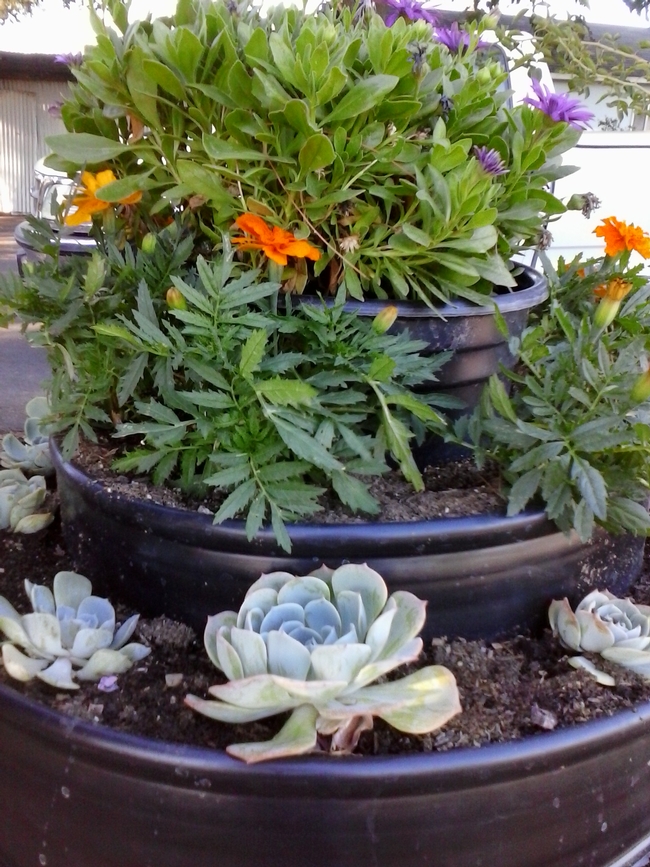
Colorful planter. (photos by Kathy Low)
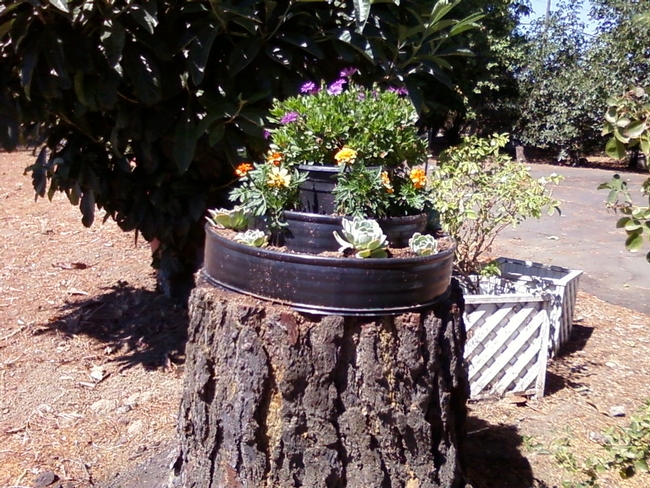
The whole view.


